The Road Back
While on a volunteer trip to Panama in 2011, first-year student Kasey Crute dove into a swimming hole. As soon as she descended below the water's surface, she felt her head hit and then a shock, like a vibration. Seconds later, she was face down in the water, unable to move or breathe. In that instant, Crute had broken her C-6 vertebra and become a quadriplegic.
On a Tuesday in late September, about a dozen UVA students, faculty and staff worked out inside the Aquatic & Fitness Center weight room. Most wore headphones and few spoke except for two students spotting one another at a bench press. Soft, light rock music played from the ceiling speakers.
In the corner of the weight room, closest to the entrance, Kasey Crute sat in her electric wheelchair, waiting. Her jean shorts hung from her hips and a UVA t-shirt fell loosely over her long, skinny frame. Instead of sneakers, she wore gladiator sandals. Her thick, long, blonde hair was tied into a loose ponytail.
Crute's trainer, Dave Brown, the owner and founder of the Ashland Athletic Club and Samaritan's Walk in Ashland, Va., stood facing her. Brown's 21-year-old daughter, Caitlin, who is also his assistant, stood behind Crute. Several students walked by and looked, their stares lingering before they turned away.
"Ready?" Brown asked. Crute nodded.
"1, 2, 3," he counted before he and Caitlin lifted Crute—102 lbs. and 5 feet 9 1/2 inches tall—out of her wheelchair and onto a bench. They placed her in a seated position as Brown tied Crute's ankles to foam blocks on the ground to steady her. Caitlin leaned Crute forward and strapped her wrists to the bench press bar.Brown counted again before he and Caitlin lifted Crute to a standing position. And for almost a minute, on wobbly, supported limbs, she stood.
"This has been hard lately because I've had issues with my blood pressure," Crute (Col '15) said. "When I go from sitting to standing, all the blood rushes down."
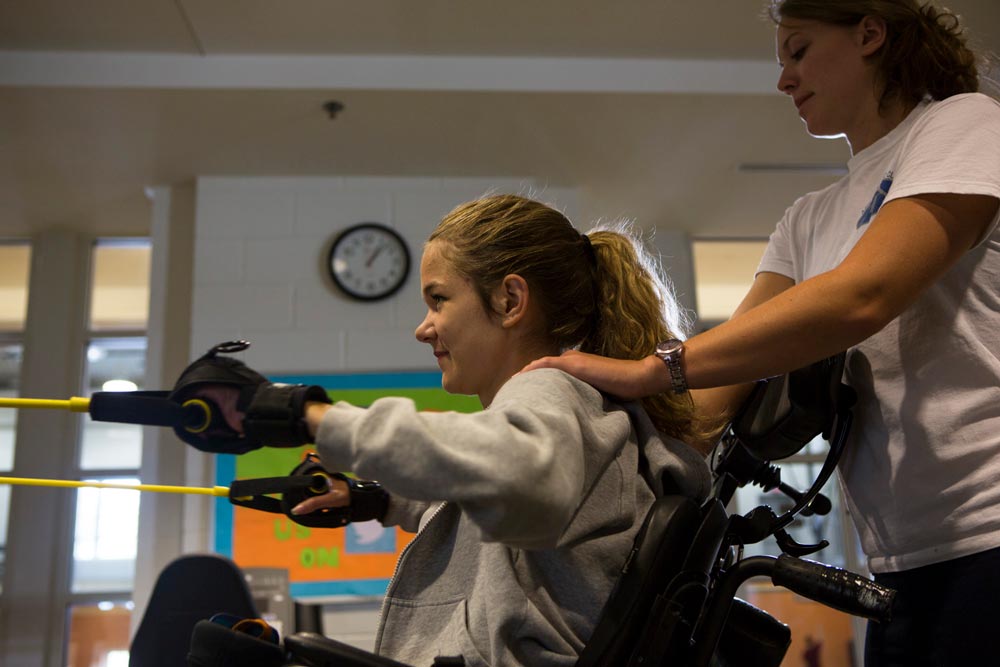
For the past year and a half, she has navigated life at UVA as one of six undergraduate students who use wheelchairs or scooters on a permanent basis because of disabilities. Crute is the only student with a spinal cord injury, an isolating characteristic that she struggles with each day. But her injury has also encouraged resiliency, and a way of experiencing college life that she might otherwise never have imagined.
Most college students don't think twice before sitting down or standing up. Before her spring break during her first year at UVA, Crute didn't either. But during a volunteer trip to Panama, Crute dove into a watering hole. She knew the water was shallow but hadn't worried about the depth after seeing children splashing around and flipping.
As soon as she descended below the water's surface, she felt her head hit and then a shock, like a vibration. Seconds later, she was face down in the water, unable to move or breathe.
With that dive, Crute had broken her C-6 vertebra and become a quadriplegic.
This Can't Be Me
Growing up in Chester, Va., Crute was a free-spirited introvert. She lived with her mother, Sherri Thompson; her stepfather; and her younger half-sister (her parents separated when she was two—her father lives in Richmond).
"We'd be sitting at her house and she'd say, 'What if we go do this spontaneous thing?' because she was so adventurous," Erica Stanley, Crute's best friend, says. "She didn't care what anyone thought; she was just going to be herself."
Arriving at UVA in the fall of 2010, Crute became involved in several student organizations and planned to major in environmental studies. She joined the rugby team and the Global Brigades, a national organization with a UVA chapter, through which she took her trip to Panama. She attended parties, made friends and embraced her independence.
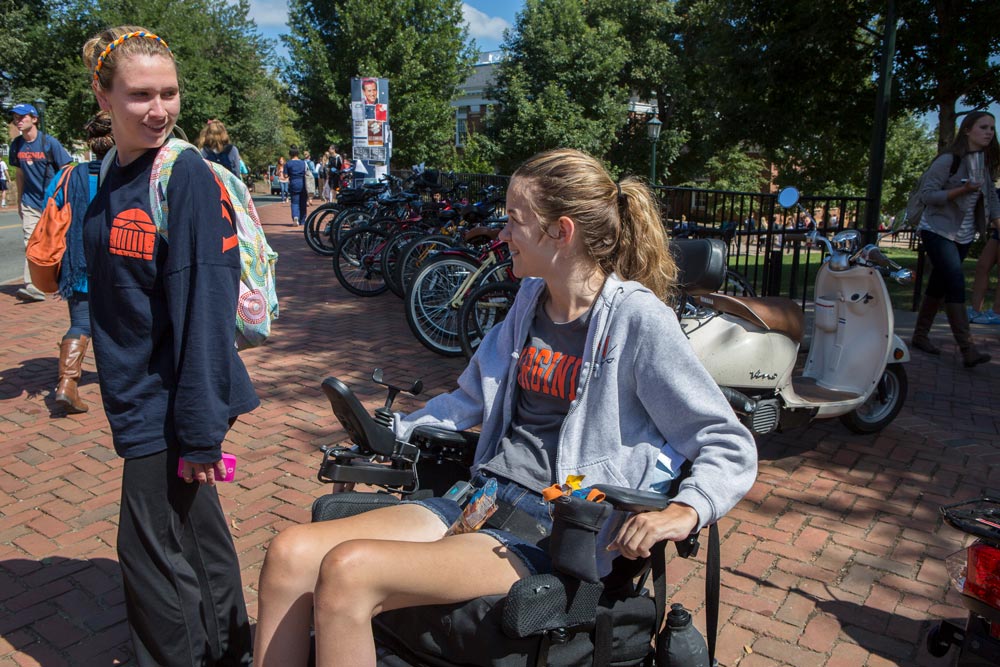
That lifestyle came to an abrupt halt after her accident. She spent three weeks in a Panama City hospital before returning to Charlottesville, where she spent 10 days at the UVA Medical Center.
"That's when they first told me I had a complete spinal cord injury," Crute says. "I kept thinking, 'This can't be me.'"She became more aware of her new reality—and its limitations—during her five-month stay at the Shepherd Center in Atlanta, a private, nonprofit hospital for people with spinal cord and brain injuries. While there, Crute learned how to move through the day—apply makeup, eat and push a wheelchair—without full use of her hands and fingers.
Paralyzed from the top of her shoulders downward, she is considered a quadriplegic because, while she has some upper-body range of motion, she doesn't have full use of her hands and arms.Crute moved home for almost a year after her stay at Shepherd. She returned to UVA in June of 2012 for summer classes and as a full-time student a few months later. "I toyed with the idea of not coming back, because I felt like nobody would understand my situation," Crute says.
Still, she hoped being back in Charlottesville could offer new opportunities. "Kasey enjoys being at school and with her peers, people her age," Thompson says. "She's always been a thinker and I think it challenges her, and that's good."Returning to Grounds
Crute's life on Grounds is a stark contrast to her first year. She is a second-year student even though her original classmates are fourth-years. At 21, she's not sure when she'll graduate. "I was so ready for my life to begin when I turned 18 and got out of the house," Crute says. "Now I'm in college for who knows how many years."
She has almost 24-hour care and keeps a accessible van parked near her dorm suite in Brown College. When she first returned back, she preferred pushing herself in a manual chair, which had semi-automatic wheels, and relied on friends to help her move into and out of class buildings. She attended the occasional party and spent time with old friends while making new ones. She went out on several dates with an upperclassman before the two drifted apart.
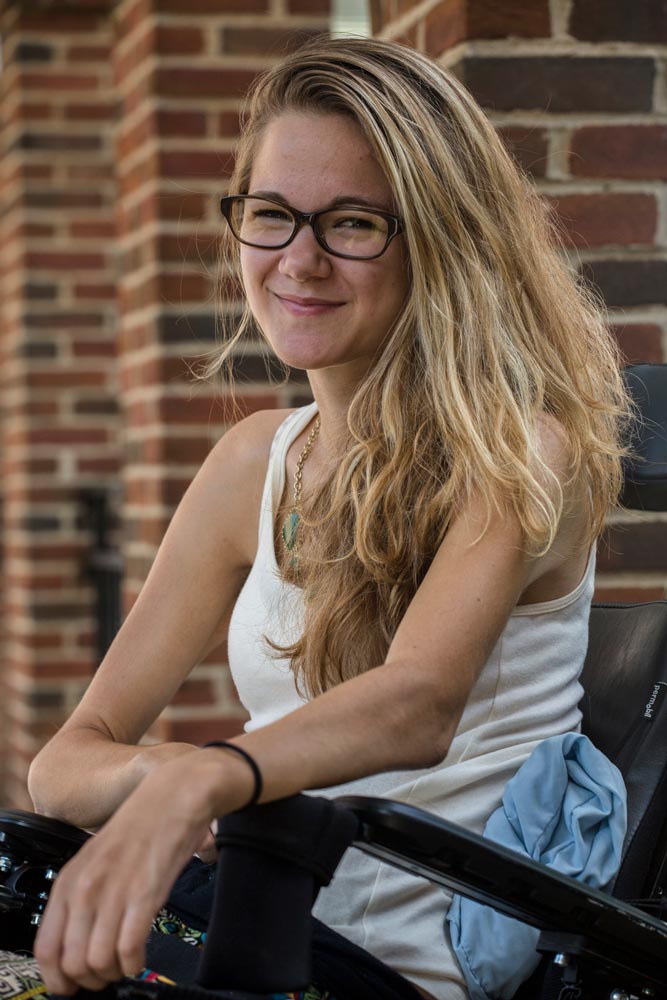
But then, last March, she experienced a major setback after falling out of her chair, injuring her neck and back muscles. She had to start using a power chair, which she dreaded because it was so much larger. "I was terrified of this chair because of how it looked," Crute says. Now, seven months later, "I'm getting over the stigma of being in it," Crute says.
She's experienced increased joint and muscle pain throughout her body since her accident, and those pains have peaked this semester.
"People think when you're paralyzed, you don't have feeling," Thompson says. "They don't realize there are nerve connectors and phantom pain. Kasey is having a lot of problems with that now." Crute sees a pain management specialist regularly, as well as a psychologist.
Seeking new ways to manage the pain, Crute enrolled in a meditation elective last spring. Nick Trautz (Grad '19), a Ph.D. student in the History of Religions program who helped teach the meditation class, says Crute has remained resilient throughout her rehabilitation.
"Through her journal submissions, it was clear that she was earnestly engaging with the course material," Trautz says. "Kasey's reflections demonstrated an ongoing commitment to working with the mental and physical hardships that arise with her new way of being in her body. Some of her entries were heartbreaking, others inspiring. There seemed to be some sort of journey taking place in terms of how she was relating to her body and mind."
Crute says the course has helped—not only with pain management but also in controlling her stress levels and her attitude toward her body.
During the beginning of the school year, her grandmother, her Meme, was her 24-hour-a-day aide, living in Crute's suite in Venable dorm. Crute and her grandmother have an easy rapport and worked together well. After her grandmother left in mid-October, Crute hired daytime help and worked with UVA nursing students at night. She posted a photo a few days later to her Facebook page, captioned: "Not missing her instant mashed potatoes, but missing Meme already."
Friends sometimes stop by to visit Crute and she makes plans to hang out with them around Grounds. Stanley, a senior at Radford University, visited Crute during a fall weekend. The best friends still see each other frequently and Stanley, who hopes to become a high school science teacher, is considering moving to Charlottesville once she's graduated.
"I think being back at UVA has been tremendous for her," Stanley says of Crute. "When she went home after Atlanta, she was home for about a year … she was by herself a lot, since our friends were at school. Now that she's back at UVA, she can get out, have classes, meet new people.It has been a total difference."
A Day in the Life
Crute's typical day begins around 11 a.m. Her discomfort often wakes her during the night, so she takes sleep aids that often leave her groggy.
Her morning starts with stretches in bed. Then her helper lifts Crute from the bed, supporting her with one arm under her knees and the other under her armpits, and places her in her wheelchair. Next, she wheels into the bathroom.
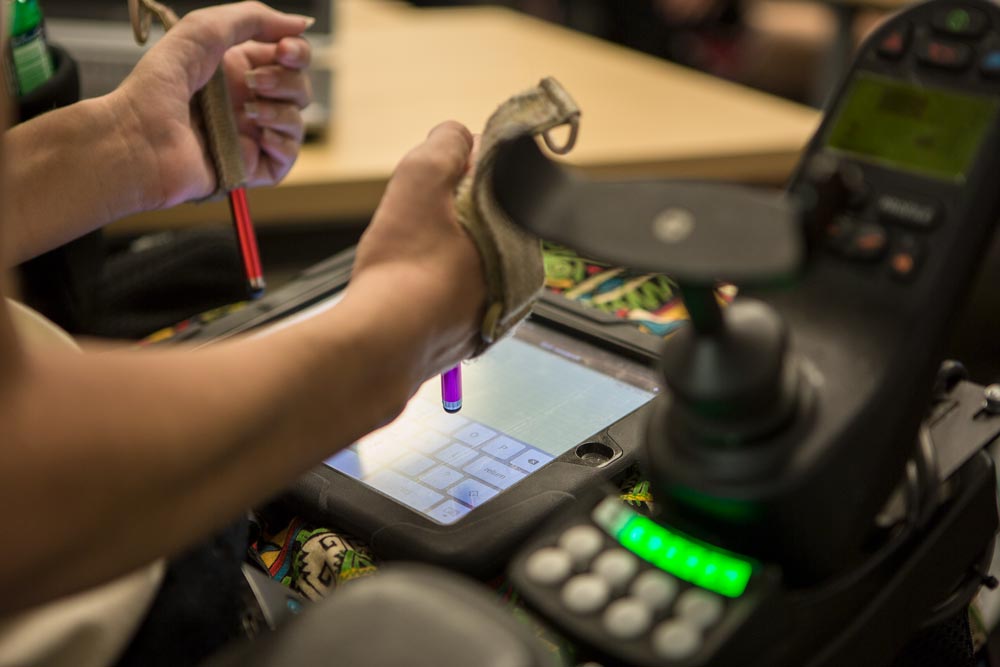
Crute loves putting on makeup but rarely wears it because of the time it takes her to apply. Her makeup is stored in Ziploc bags on her bathroom windowsill. Sitting in her wheelchair, she looks into a handheld mirror while sweeping a neutral-toned eyeliner across her eyelids. She asks for help uncapping her eyeliner, but otherwise manages the brushes, pens and powders independently.
Crute grips objects—a fork, an eyeliner pencil, an electric toothbrush—between curled fingers or her fists. She is adept at texting and attaches a stylus to her hand with Velcro when typing emails or papers.
Crute's Brown College suite has a common room, two bedrooms and a bathroom. She has a microwave and small refrigerator, but no TV. Boxes of snacks sit on a table. In the faux fireplace in the corner of her suite sits a therapy bike that stimulates Crute's muscles through electrodes attached to her body. Under Dave Brown's supervision, she'll sit on the bike for up to an hour several times a week.
Crute signed up for seventeen credits this semester but was soon overwhelmed, so she reduced her course load to eight. Sometimes, just getting to class is hard enough. One recent September evening, exhausted at the idea of maneuvering across Grounds for an evening class, she left her dorm room, sat outside in her chair in the setting sun and watched students pass by.
"It seems like the life around me is a cartoon, maybe because I'm not physically interacting in it," Crute says. "I'm wondering if people are aware they're alive, seeing things, tasting, touching. They just move from one thing to the next, unaware."
Stanley said she worries about her friend's emotional health.
"I think she gets sad," Stanley says. "It's not a walk in the park. It's a roller-coaster ride. One minute she calls me and she's super excited about something, and two weeks later, she'll call and things aren't going as well. She has times where she gets stressed and depressed and feels overwhelmed, but every time she comes out of it. It's a day-by-day thing. She tries to be positive as much as she can."Crute's mother agrees, and says her daughter has a wise take on things. "Kasey was always described by my family and friends as an old soul," she says.
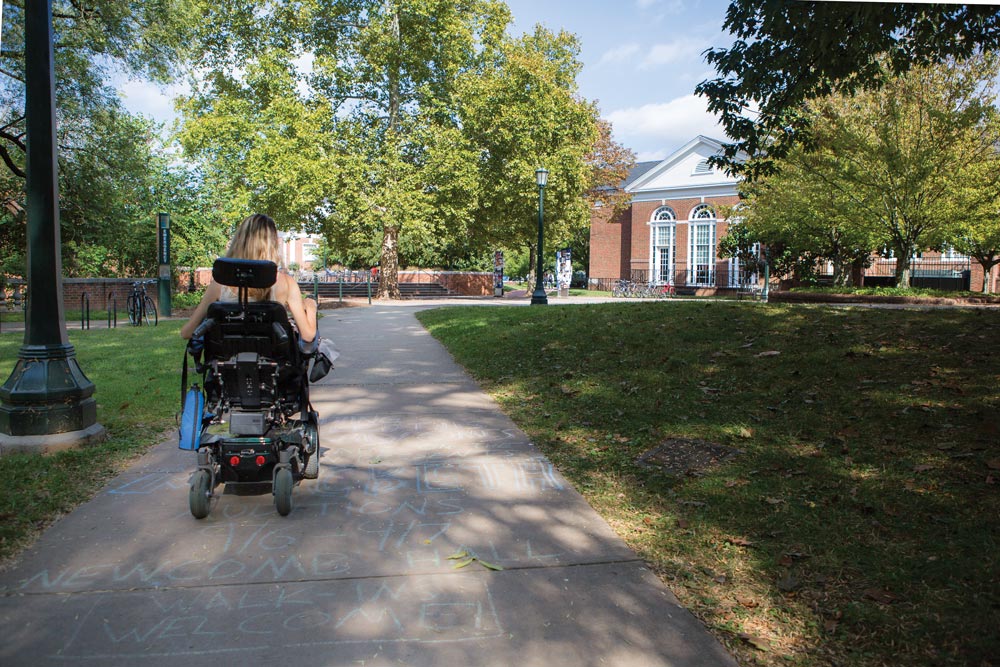
After finishing the Thursday workout session, Brown drove Crute's van back to her dorm. He parked on the brick sidewalk, opening the sliding door as Caitlin unbuckled Crute's wheelchair from the seatbelts. Crute exited via a side ramp, weaving through the lunchtime foot traffic before positioning her chair next to a bike rack packed with bikes.
A friend stopped and gave Crute a hug, chatting for a few minutes before walking onward. Crute waited for the sidewalk crowds to disperse before directing her power chair toward her dorm room. Sidewalk chalk drawings decorated the sidewalk. Flowers bloomed along the building's edges.
"I was exceptionally independent before this," she says. "I haven't lost that in my mind."
